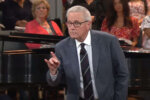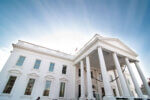Church today is no longer just black and white. A wave of immigrants has created a vibrant kaleidoscope of ethnic variety.
Immigrant churches are no longer just small bands of people who meet in the sanctuary on Sunday afternoon for worship in their native tongue. Rather, they are a force to be reckoned with—a growing group who are networking and setting their sights on transforming America’s culture and reviving its Christianity. In the process they are providing a model for spiritual renewal and social action that puts them on the leading edge of church development.
City Blessing Church in Claremont, California, for example, fills up quickly on Sunday morning with young professionals and families pushing strollers. The parking lot sparkles with late-model cars. A bookstore in the foyer sells popular Christian books and music CDs. In the sanctuary a worship band warms up with well-known songs, and soon the people launch into a time of joyous worship—in Indonesian.
Based on outward appearances, a person could take it for any church in America. But it is the mother church of the City Blessing fellowship of churches led by Paul Tan, a businessman-turned-minister who is one of many immigrant pastors changing the face of American Christianity. “Even though we are immigrants, I believe we are to be a blessing to this country,” Tan says, echoing a sentiment voiced by more than a dozen immigrant pastors Charisma interviewed.
Immigrants make up more than 12 percent of the U.S. population, and that number is increasing. Most come to find opportunity or flee hardship.
Tan came to the U.S. as a university student in 1979, met Christ and was swept up in an Indonesian student revival that coalesced into the movement of churches now known as City Blessing (see cityblessing.org). The two dozen churches range in location from New York to Jakarta.
But 12 years ago, God radically changed Tan’s assignment and told him to start reaching all Americans, not just Indonesians.
“God has spoken the same thing to many people,” Tan says. “He is looking for people who have kingdom vision and want to accomplish kingdom work, not only for their local church or organization.”
Tan began partnering with “many churches and many marketplace leaders.”
“I see my role here now not only for the City Blessing Church and movement, but as a facilitator who sees transformation city after city, nation after nation,” he says. “That was different from what I’d done before in trying to reach Indonesians predominantly. When you want to see total transformation in a city, you can’t just do it within your own church organization. We have to work together.”
Through the years, the Claremont church has channeled $1 billion in food, medical supplies and more to the needy, mostly in Indonesia. City Blessing churches are also aggressively serving their local communities. Tan’s church gives away food weekly to 70 neighborhood families, most of them Hispanic and black.
The City Blessing Church in nearby San Bernardino is heading an effort to renovate a community park. And Tan has started an English-speaking service on Sunday morning, even though his church is still 80 percent Indonesia-born.
Many immigrant pastors across the country say their mission, too, has shifted in the last decade to encompass all ethnic groups and bring revival to America.
Called to Reach Others
“Up to now we reached Ethiopians only,” says Hanfere Aligaz, pastor of the nearly 3,000-member Ethiopian Evangelical Church in Washington, D.C., and president of the Ethiopian Pastors Fellowship Association. “[But] the Lord has called us to reach others, not only our community. God doesn’t care about color, only about souls.
“This is what is in my heart, and the time has come.”
The Ethiopian Embassy estimates there are 800,000 to 1 million Ethiopians in the U.S., mostly concentrated in Washington, D.C., home to a thriving Little Ethiopia. Recently Aligaz asked his Sunday morning congregation to partner with him to evangelize local immigrant Koreans and Hispanics, as well as all other Americans. Ninety percent of the people stood to say they would.
Though the church still heavily supports works in Ethiopia—giving $1 million to build an orphanage there, for example—it is also reaching out to English speakers with conferences that have drawn many ethnicities.
Humberto Solano-Costa, evangelism coordinator at the Brazilian Assembly of God Bethlehem Ministry in Lighthouse Point, Florida, says this church of 400 recently decided to start English services in many of its daughter congregations throughout the U.S., even though the churches are mostly Brazilian.
“We realized that if God placed us in the U.S., it is not just to reach Brazilian people but Americans,” Solano-Costa says. “There has been a great change in the mind-set of the people of the church. Everybody now is more interested in reaching everybody.
“Before it was: ‘Why should I worry about the Americans? I speak Portuguese.’ Now it’s completely different. We are a Brazilian church with a mission to reach Americans and every other culture.”
The church now has 40 daughter churches in the U.S. and missionary works in several European countries.
Todd Johnson of the Center for the Study of Global Christianity at Gordon-Conwell Theological Seminary says one of the biggest untold stories in religion in the last decade is the immigration of millions of Christians to America. “A huge proportion of all immigrants, close to 80 percent, are Christian,” he says.
“Every two seconds an immigrant Christian comes to live permanently in the U.S. That’s a lot of people.”
The obvious result, he says, is that they are forming their own churches and worshiping in numerous languages. But beyond that, “many of these immigrant churches are actually planning to reach out to the surrounding urban and suburban white communities,” Johnson says. “From what I’ve heard, there are an increasing number of Caucasians showing up in Korean, Brazilian and Nigerian congregations.”
Tong Liu’s 2,000-member River of Life Christian Church in Santa Clara, California, is one of those churches that is working to become multiethnic. “We want to enlarge our ministry, make a great impact on the city and bring transformation to this area,” Liu says. “We are majority Chinese now, but we have a big slogan in the lobby that says, ‘Home for All Nations.'”
There are about 3 million Chinese immigrants in the U.S., making up America’s largest Asian group. They are concentrated heavily in the San Francisco Bay area and New York City.
Liu’s church now partners with non-ethnic churches and has cultivated a good relationship with city leaders. Like many immigrant churches, River of Life offers live English translation via headphones during its native-language services.
For many immigrant churches, broadening their approach is seen as critical to their survival. Second-generation believers almost universally prefer services in English and want a more American-style church culture.
“The second generation speaks English more than [Spanish], so we are doing the crossover,” says Guillermo Maldonado, pastor of the 8,000-member Ministerio International El Rey Jesús in Miami. He preaches bilingually and is about to start an all-English service. “We need to reach the next generation. We have no choice.”
Carriers of Revival
Many immigrant churches feel a special calling to spiritually rejuvenate America.
“We definitely feel we have a role in bringing revival and reformation,” says Aligaz of the Ethiopian church. “The Lord spoke to us that we would be one of the peoples to bring revival to America.”
Solano-Costa, the Brazilian pastor, says the people in his church “want to awaken the American church. America is the nation that sent more into missions in the entire world. We are the result of U.S. efforts. We are here to pay back the favor.”
Russian pastor Gennadiy Zavaliy of Evangelical House of Prayer in Brooklyn, a network of six churches with 1,000 members, says he is “surprised that American Christians are not as excited about” evangelizing their own country.
“They will spend a lot of money to send missionaries to India or Africa, but today America needs missionaries and evangelism here,” he says. “If we don’t open churches, someone will open mosques.”
Maldonado agrees and says he believes the recent political backlash against immigration is because “the enemy is trying to stop the revival coming to America”—an opinion he shared recently with members of Congress.
Demographic data may agree with that assessment. There are 42 million Hispanics in the U.S., fully 14 percent of the total U.S. population. A recent study by the Pew Hispanic Center found that Hispanic immigrants, by far the largest immigrant group in America, are about 90 percent Christian and are twice as likely to be Pentecostal than are American Christians. In other words, the U.S. is importing Pentecostals and charismatics from Latin America.
This “could make some U.S. churches uneasy,” Johnson says. “There’s a lot of evangelicals who are pretty secularized. This influx of global Christianity is going to maybe teach a little lesson.”
But some immigrant pastors are cautious about having a crusade mentality toward the U.S.
“In a general sense we do believe the church in the U.S. should be more on fire for God, but I’m careful not to get into a way of thinking that becomes judgmental,” says Marco Barrientos, pastor of Centro Internacional Aliento church in Dallas. “We should work together as one body, not as bodies of certain color or language.
“We are endeavoring to respect and honor, which is something we learned from U.S. missionaries, to create bridges and ways of working together as opposed to bringing our own flavor of revival and saying, ‘You need to embrace what we have.’ I don’t think that way, and I don’t think it would be appreciated by American Christians.”
Indeed, some churches have struggled to draw from outside their own ethnic groups. The Redeemed Christian Church of God (RCCG), founded in Nigeria in the 1950s, has positioned itself in the U.S. as a church for all peoples. Services are in English and most elements of a Sunday service would fit into a typical American church service.
“It’s not called the Nigerian Christian Church of God, it’s called the Redeemed Christian Church of God,” insists James Fadele, chairman of the board of coordinators for RCCG North America.
But the process of integration has been slow. The vast majority of people in North American RCCG churches still are Africans, primarily Nigerians. Fadele concedes that “people tend to be cliquish. … We need to break out of that mode.”
Bayo Adewole, overseer and pastor of eight RCCG churches in Chicago, says, “Ideally we are supposed to reach everybody, but now we are 99.9 percent African. I don’t know why it has turned out this way.” But, he says, his churches hope to draw more non-Africans, and they have “prepared [themselves] to receive everybody.”
Holistic Ministry
Immigrant churches also believe in meeting practical, workaday needs as part of their spiritual mission, and many are becoming more sophisticated in how they deliver services to new immigrants. Many immigrant churches offer English classes and help finding jobs and a place to live.
Zavaliy, the Russian pastor in Brooklyn, says his church hosts doctors who give free medical help to immigrants lacking medical insurance. At Brazilian Assembly of God Bethlehem Ministry, businessmen identify talented workers and recruit from within the church.
For a majority of immigrants, the most pressing need is to gain permanent residence in the U.S. Maldonado says unscrupulous lawyers take advantage of recent immigrants, so his church has its own lawyers to help people get their immigration paperwork in order.
At Tan’s church, part of the weekly prayer meeting is devoted to praying for people who are trying to gain residency or asylum. People who have received asylum pray for those who haven’t, giving an “impartation of favor,” according to Tom Lay, Tan’s assistant pastor. He claims a 90 percent success rate for last year.
Many churches also provide career counseling, computer training and business courses. Ethiopian Evangelical Church offers a wide range of classes and services, “like an information center for everyone who wants it,” Aligaz says. “The holistic ministry has been very helpful.”
City Blessing has elevated entrepreneurial training to a high level of importance. Tan encourages people to start businesses and offers leadership development courses to adults and children as young as 10 years old.
On a recent Sunday afternoon, 15 preteen kids gathered in the Claremont sanctuary to learn the basic elements of an entrepreneurial mentality: confidence, leadership, organization and more. As a result, many in Tan’s church have gained the courage and skills to go into business. For Tan, it’s part of transforming cities and nations not just through prayer and the spiritual gifts, which operate widely in his services, but also through excellence in the public sphere.
Barrientos in Dallas says much of his work is simply helping people who fear being deported and are frustrated by their inability to communicate well. One man recently came to Barrientos distraught because he had received a jury summons in the mail and thought he was being sued. “When I explained to him [what it was], he had a big sigh of relief,” Barrientos says.
Another challenge for new immigrants is avoiding the traps of greed and immorality. Aligaz says many Ethiopians come to America and “get carried away with material things and become very cold. Most of our great Christians are not those who came as a Christian but those who have been saved right here in Washington.”
Barrientos agrees that the main challenge for people moving to the U.S. is materialism and sexuality. “People here are able to earn enough money to do things they would never do at home, like get cable TV or an Internet connection,” he says. “With that comes the corruption and perversion that comes through the media. Many immigrants are not well prepared to face that onslaught.”
He says many immigrants arrive when they are young adults and their character is “not completely formed yet, so the church becomes an agent of formation of character and the pastor becomes a father figure for them in a very practical way.”
The City Blessing Church in Temple City, California, holds its evening service in a rented Lutheran church. At least 250 Indonesian people pack into the traditional A-frame sanctuary with wooden pews and launch into some of the liveliest worship on the West Coast.
A worship team made up mostly of young women leads popular American worship songs translated into Indonesian. People flood forward to hop, sway and lift their hands. Even elderly people raise their hands and sing with gusto.
The 2000 U.S. census estimated there were 72,000 Indonesians in America, but it’s believed that many more are here illegally, having fled religious and ethnic persecution. Most of the people in City Blessing churches were converted from atheism, Buddhism, Confucianism and Islam after they came to the U.S., Tan says. Many were cultural Catholics who met Christ for the first time here.
“It’s definitely easier for them to convert here,” Tan said. “They are out of their comfort zone.”
Tan preaches in Indonesian with an open Bible and an open Apple iBook perched on his pulpit. After the sermon and a time of intense prayer, the people stream into the fellowship hall to share a meal together, as they do after every weekend service. This is their community, and they believe that together they can change the nation.
Joel Kilpatrick is a journalist and the creator of LarkNews.com, the world’s leading Christian satire site. His most recent book is A Field Guide to Evangelicals and Their Habitat. He lives in Southern California.
Immigrant Voices
These immigrant church leaders are reshaping the way Americans do church. And you can learn from them.
Marco Barrientos
Marco Barrientos left a large, multinational concert and conference ministry in Latin America to minister full time in the U.S. “Every time I came to the U.S., I would end up in tears looking at the condition of immigrant people,” he says. “I felt they were like sheep without a shepherd.”
In 2004 he founded Centro Internacional Aliento church in Dallas (aliento.org), which now draws 350 on Sundays.
“One of the most important trends I see is immigrants coming to the U.S. already saved and filled with the Holy Spirit and wanting to make a difference,” Barrientos says. “In many cases they have been part of churches in Latin America where they are soul winners, so when they come they bring their revival with them.”
Valson Abraham
Valson Abraham founded Indian Christian Assembly of Los Angeles (icalos angeles.com) in his home in 1982. Today he oversees cell churches for Indians throughout Southern California.
“My vision has always been to reach non-Christians,” says Abraham, who is the general secretary of the India Pentecostal Church, the largest Pentecostal movement in India, which now has 70 churches in the U.S.
There are 1.5 million Indians in the U.S., concentrated mainly in California, New England and Seattle. Many in Abraham’s church come from Hindu backgrounds, and they often attend church for months before accepting Christ.
“There is a very good sense of community,” Abraham says. “I emphasize expository teaching, yet we are seeker-sensitive.”
Sunday services include a time of prayer and the laying on of hands, and a question and answer time about the Bible. About a quarter of the people in the church have come to the Lord within the last 15 months.
“We have had a great response in the last seven years by people who have never heard the gospel,” Abraham says.
George Rafidi
George Rafidi, a Jerusalem-born Arab, and his wife, Jessica, started Arab Outreach Ministries in Jacksonville, Florida, in 1996. “It’s long-term ministry,” George says. “It’s loving people and letting them see Jesus in you.”
They visit homes and businesses daily to build relationships with refugees from Iraq, Sudan and elsewhere. The couple often helps them get attorneys, jobs and driver’s licenses, as well as filling out applications and translating for them at the immigration office. On Sunday night they hold an Arabic church service.
The 2000 census estimated there were 1.2 million Arabs in the U.S., though Rafidi believes the number is at least 5 million today. Most Arab immigrants live in California, Florida, Michigan, New Jersey and New York.
Rafidi encourages people not to “look at the Arabs through the eyes of the media but through the eyes of Jesus, as people who need the Lord.” He is president of the Arabic Assembly of God Fellowship USA, which has 13 ministries in the U.S.
Gennadiy Zavaliy
Russian pastor Gennadiy Zavaliy and his wife, Helen, came to New York City after a wave of persecution forced them from Latvia in 1997. Their House of Prayer Church Ministry (churchny.org) has blossomed into six churches with more than 1,000 Russian immigrants, most of them new converts, including Russian Jews and Muslims.
“When many Russians came to America they thought everyone was waiting for them,” Zavaliy says. “They believed that houses, new cars were waiting. Many have more problems here than in Russia.”
Most of the people the Zavaliys are reaching are university educated. Many struggle with depression, loneliness, even suicide. There were 2.6 million Russians in America in 2000, according to the U.S. census.
“We are amazed at what God is doing,” Zavaliy says. “I believe that God can do even more. The purpose of our church is to be a blessing for the country which God moved us to.”
Hanfere Aligaz
Hanfere Aligaz was an airline pilot in communist Ethiopia when he met Christ through American missionaries, and he came to Washington, D.C., to start a church.
“I had no money, no green card, no place to meet,” he says. But his Ethiopian Evangelical Church (eechurch.org) has grown from five people to nearly 3,000, making it the largest Ethiopian church outside Ethiopia, he says. All services are in Amharic, but the church is beginning to reach out deliberately to non-Ethiopians.
“We believe that revival is the only way to get people saved,” Aligaz says. “People need to see the hand of God, the healing power of God. … When they do, their hearts open to the gospel.”
Aligaz’s church offers “holistic ministry” such as job training and help with immigration status. “We have to be a blessing to America because America has been a blessing to us,” Aligaz says.
Guillermo Maldonado
Guillermo Maldonado started Ministerio International El Rey Jesús in Miami (elreyjesus.org) 11 years ago with a dozen people in his living room. Today the church counts 8,000 members, most of them new converts and first-generation immigrants.
“I didn’t know we would reach this many nationalities,” Maldonado says. “I thought it would be mainly Latin American people. After I started I got people from Europe, Africa and Asia coming.”
A strong reliance on prayer, personal discipleship and demonstration of the supernatural have contributed to growth, he says.
“Every time we do a miracle service we see thousands of people come. They are hungry to see the supernatural,” he says. “I think there’s something in the Hispanic community which America needs. … Latin American people are bringing revival to America.”
Bayo Adewole
The Redeemed Christian Church of God in North America (RCCG) has grown from a living room fellowship 14 years ago to 275 churches in the U.S. and Canada. Bayo Adewole oversees eight RCCG churches with a combined membership of more than 1,000 in the Chicago area (see jesushouse.org). They have a strong “social reformation” ethic that drives them to serve the homeless and encourage people to get a higher education.
“It’s a joy to be in this great city in America and to see what God has done in the last 10 years,” Adewole says. “From a few friends gathered together we now have eight strong churches, and we are building strong families.”
The RCCG, based in Nigeria, is known for its emphasis on holiness, its high degree of organization and its expectation that every person be trained into ministry. Services are in English and the churches aggressively court non-Africans.
Tong Liu
Meteorologist-turned-minister Tong Liu founded River of Life Christian Church (rolcc.net) in Santa Clara, California, in 1995. It is now the largest charismatic Chinese church in North America with around 2,000 people, many of them young families and Silicon Valley professionals.
“God has done much more than I expected,” Liu says. “I didn’t realize a church [like ours] could grow that big or do cross-cultural ministry.”
River of Life has planted 58 churches in the U.S., Africa and Mongolia. Though the church is still mostly Chinese, they increasingly partner with and reach out to non-Chinese.
“If ethnic churches don’t just focus on reaching out to our own people … we can truly bring a great impact to the whole American church,” Liu says.
Joel Costa
Assembly of God Bethlehem Ministry (adbelem.org), a Brazilian church of 400 in Lighthouse Point, Florida, pastored by Joel Costa, was planted as a missionary work by a church in São Paulo, Brazil, in 1995. Since then, the church has planted 40 churches of its own and is reaching Portuguese, Spanish and English speakers throughout Florida.
The church recently began holding large-scale community outreach events a dozen times a year throughout central Florida, giving away free hot dogs, haircuts and car washes and hosting a garage sale. People are invited to return that night for a service at the church.
The church also has launched a ministry to help new immigrants take their first steps toward getting settled, such as obtaining a driver’s license and renting a place to live.






Leave a Comment
You must be logged in to post a comment.